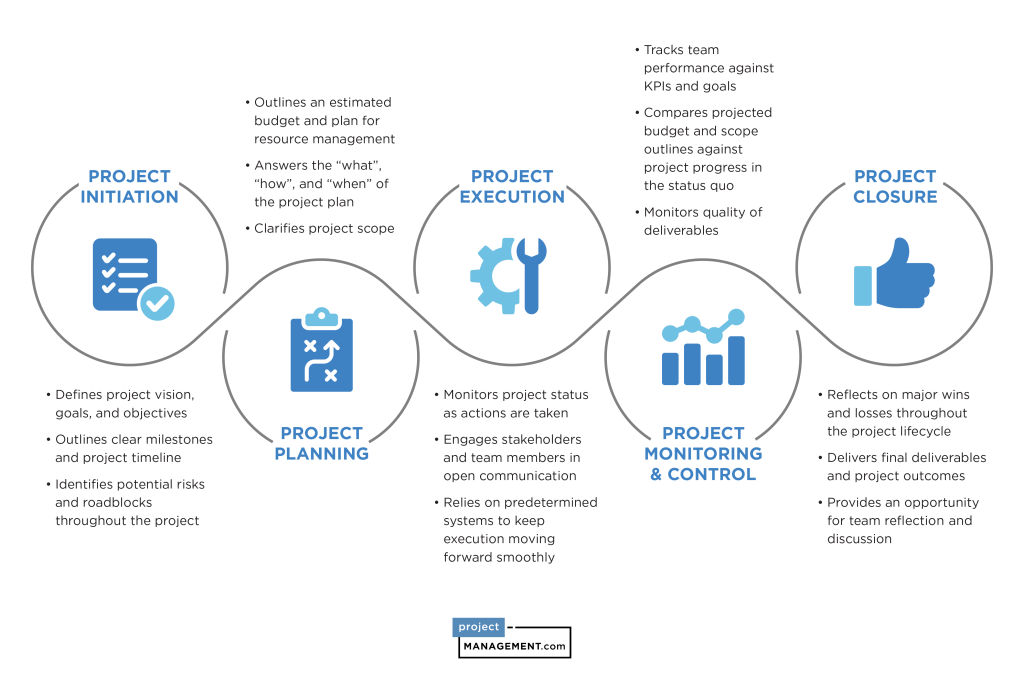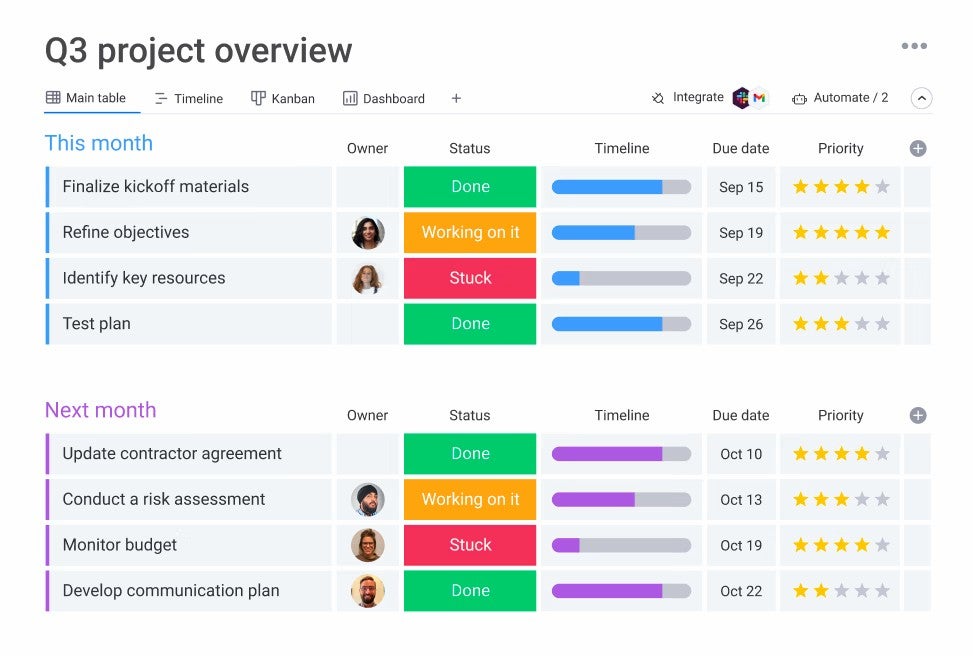KEY TAKEAWAYS
If you’re just diving into the world of project management for the first time, you might feel intimidated by starting a new project. Fortunately, you can utilize the project life cycle, which is a set of stages that takes a project from start to completion. Read on to learn about each phase of the project lifecycle, its role in the success of the project, and how you can properly manage each phase for optimum results.
What Are Project Phases?
Project phases are smaller portions of a project that represent distinct goals or milestones in the larger project lifecycle. Within the project life cycle, there are 5 project phases, as defined by the Project Management Institute:
- Project initiation
- Project planning
- Project execution
- Project monitoring and control
- Project closure
An entire project comes with a lot of requirements before it could even start, which are often gathered during the discovery phase or requirement phase. Once the project kicks off, each stage of the actual execution itself has another set of specific requirements of the project team, as well as key deliverables and action items that keep the project moving forward successfully. Mastering project phases is essential for keeping the project on track while completing essential tasks and checkpoints throughout the process.
READ MORE: 14 Important Questions Project Managers Should Ask the Team
What Are the 5 Project Management Phases?
Project initiation
A team’s performance during the project initiation hase can result in either authorization, delay, or discontinuation of a new project.
The main goal of the project initiation is to ensure that the project meets business needs and that stakeholders and project teams are aligned on the project success criteria throughout the project life cycle.
To achieve the project goal, it’s best to involve internal and external stakeholders from the initiation phase. This way, you can effectively align expectations and increase the likelihood of completing all the deliverables throughout the project management life cycle.
During the initiation phase, the entire project team defines the project idea, and the project sponsor evaluates it and authorizes the project to proceed. The project manager starts the documentation process, which includes the justification, deliverables, risks, estimated cost, and resource requirements.
The project charter is a key deliverable of the project initiation phase and contains all this information. It is the first formal definition of the project. It authorizes the project to exist, establishes the authority of the project manager, and documents high-level requirements, project milestones, and success criteria.
Another important document in the initiation phase is the stakeholder register. This document includes information about all the stakeholders of the project. It identifies the people, groups, and organizations that have an interest in the task, project, and its results.
Approval of the project charter signals the advance of the project to the next phase, the Project Planning Phase.
READ MORE: What is a Project Charter? Complete Guide & Examples
Project planning
Once the expectations and success criteria are clear, the next project management life cycle phase focuses on planning each task the team needs to perform to cover the scope, achieve the deliverables, and meet the overall goal.
In the project planning phase, the project team members dive into specific requirements, tasks, timelines, and actions. The project manager works with the entire team to create the design, enumerate the task list, and estimate the budget.
The project team builds the resource plan, the communications plan, and the initial project schedule. The project manager also establishes the roles and responsibilities of the team and stakeholders. The project scope is finalized depending on approved available resources and client priorities.
During the planning phase, the project team finalizes the work breakdown structure, project plan, requirements list, communications management plan, and other relevant documents to iron out the workflow and coordination with involved parties.
The project plan is a key deliverable and contains a detailed work breakdown structure (WBS) or task list with start and end dates, and estimated effort and duration. It identifies milestones, resources, and the schedule. It also includes task dependencies that will allow the project team to use the critical path method if it chooses.
Other important deliverables are the communications management plan, which helps facilitate effective communication with stakeholders, and the resource allocation plan which identifies the schedule of project team resources as to their availability during the whole project life cycle.
Something PMs should keep in mind: as you discover more information, you may have to adjust your previous project plan and related procedures. More complex projects will require more back-and-forth approvals for every task created.
Project planning is an iterative process so the project manager should review, revise, and revisit all the plans at least once a month until the completion of the project. It is crucial for the project team to involve relevant stakeholders in this stage of the project life cycle as well.
READ MORE: Project Management Communication Plan
Project execution
The project execution phase is where the project team executes and follows through on tasks based on the project plan. At this stage, the team spends most of its time coordinating with people, helping to ensure quality work, staying within the project timeline agreed upon, keeping track of resources, and updating stakeholders.
Sometimes called the implementation phase, this is the phase when the project manager tries to manage every task and aspect of project delivery to keep the project on track for the remaining duration of the project life cycle.
The project team focuses on achieving all the objectives set in the earlier phases. At this phase, the project leader likely uses project management software to assign every task to team members. Tools that centralize task information, along with resource availability and team communication can simplify and optimize the needed project management processes.
Quality assurance documentation, meeting minutes, and work orders are some of the documents created during the execution phase of the project management life cycle.
It’s also likely that you’ll discover new information that will require a revisit and update of the initial project management plans. Be vigilant with change requests, and make sure that the necessary adjustments are managed.
READ MORE: Understanding Different Types of Stakeholders and Their Roles
Project monitoring & control
The best way to ensure progress and improvement is by tracking and reviewing project performance.
Simultaneously during execution, the project team carefully tracks the progress of the project based on the project plan established earlier. Tracking the performance of the project through various metrics is crucial to ensure the project stays on schedule, within budget, and within scope.
The project team keeps track of change management documents, spending records, QA checklists, and team time tracking. They are able to measure where efforts and resources go throughout the project life cycle, crosschecking it with the project plan.
Both the execution phase and monitoring & control phase are critical times that can determine project success. Aside from monitoring the progress of tasks, the project manager also tries to identify issues or risks, creates a mitigation plan with the team, and reports the project status regularly to stakeholders.
Being diligent in recording and measuring project progress puts the project team in a strategic position. They can identify bottlenecks and initiate essential discussions or project management process improvements.
Having a proactive approach will allow the project team to respond rapidly to any change in the plan. Consistent and appropriate status reporting will update interested stakeholders and provide them the opportunity to intervene in or redirect the project as needed.
If additional planning, time, or resources are needed, you’ll need to communicate them to relevant project stakeholders before it’s too late. You’ll also have the data and results to back up your requests, so you have a better chance of justifying your requests and maintaining their trust despite circumstances.
READ MORE: 10 Best Project Management Software Buyers’ Guide
Project closure
In the last project management life cycle phase, all the activities related to its completion are concluded. These may involve the submission of a final deliverable, fulfilling contractual obligations, terminating relevant agreements, and releasing project resources.
The causes of a project closure can be completion, cancellation, termination, or transfer to a new organization. The documentation required to complete project closure will differ depending on the situation.
In this phase, the project manager communicates the final project disposition and status to all stakeholders. This phase also ensures to inform participants and stakeholders of any follow-on activities or continuing product life cycle so they can communicate and coordinate with the people in charge.
Regardless of the outcome of the project life cycle, however, it would be good for the team to conduct a project retrospective. During this post-mortem activity, the project team can process new lessons and ensure the improvement of current project management processes for a future project.
During the project closeout, documents to turn over can include various project documentation, final meeting minutes, and other closure reports. These documents can identify and capture lessons learned and best practices for future reference and reuse.
It is a good idea to organize and store project materials in a shared team folder. These materials can provide reference during performance evaluation. The opportunity to continuously test, improve, or reinvent ways to manage the whole project life cycle can help grow the organization and its business.
READ MORE: How to Host a Good Project Post-Mortem Meeting
VIDEO: Recap of 5 Project Management Phases
Why Are Project Phases Important?
All projects go through each of the five phases regardless of their size.
The decision to officially divide a project into phases is an excellent way to manage the team’s focus, allocate resources, and align the entire project life cycle with clients and stakeholders.
By thinking in terms of phases, the project team ensures that deliverables produced at the end of each phase meet the project’s goals. Managing a project by phase also makes sure that the team is properly prepared for the next phase.
Project life cycle phases provide additional benefits. The approach provides a structured approach for project delivery. Defined activities, outputs, and responsibilities create a clear and common roadmap for the project team to follow.
Defined phases and defined roles show a visible framework easily understood by all team members and stakeholders. Assignment of responsibilities by phase clarifies what the team should only be doing in each phase and helps streamline communication.
Working on projects phase by phase helps track and link progress directly to each phase. Completion of each phase is easily recognizable by all involved.
Another benefit of project management by phase is the progressive evolution of the project. This helps identify areas that need greater attention for a particular phase. It also marks clearly the points and opportunities for structured reviews to support project governance.
Though equally important, they are not to be confused with the process groups outlined in PMBOK’s IPECC model, which also includes initiation, planning, execution, control, and closure but refers to a collection of activities needed to achieve specific goals. Process groups are sometimes considered part of project phases.
While PMBOK recommends assigning project phases according to a project’s life cycle, project teams can follow their own system depending on their industry, organizational policies, and other relevant factors. For example, teams and organizations focused on monitoring the usage of resources can use the critical chain project management methodology.
READ NEXT: 100+ Important Project Management Terms & Concepts to Know









